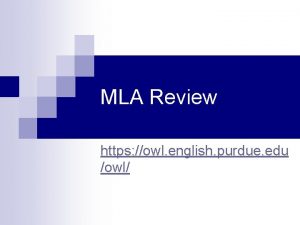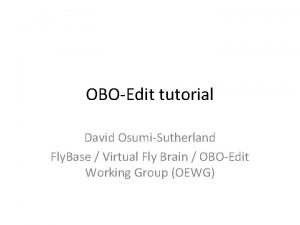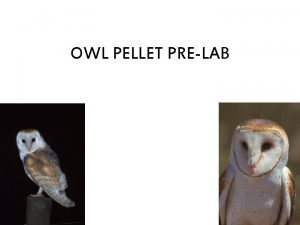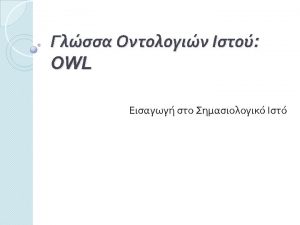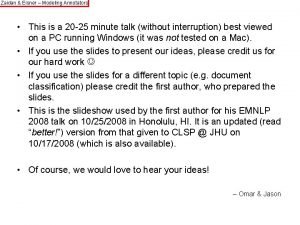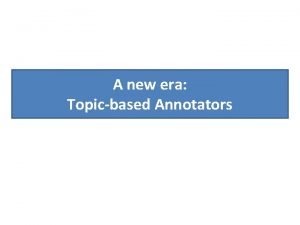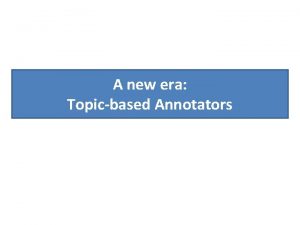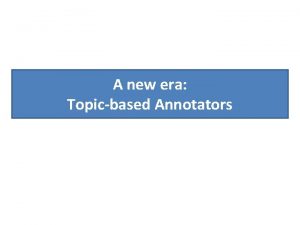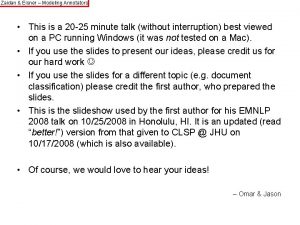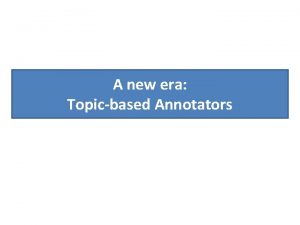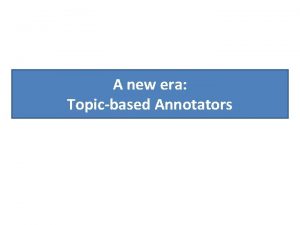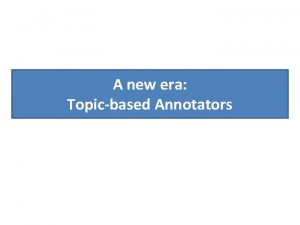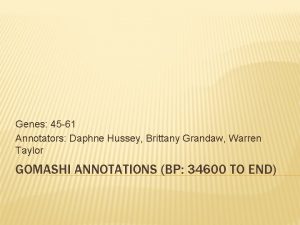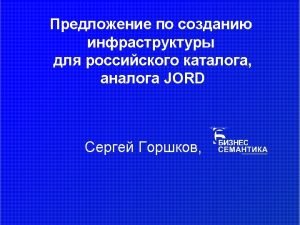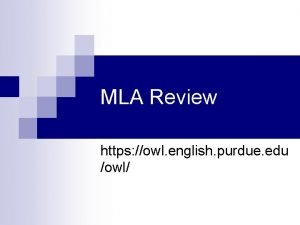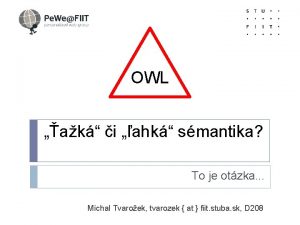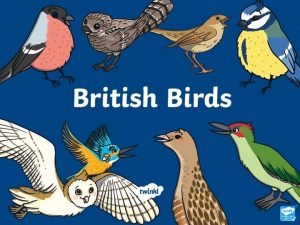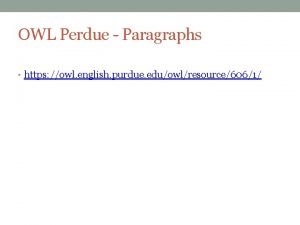OWL for annotators David OsumiSutherland What is OWL






























- Slides: 30

+ OWL for annotators David Osumi-Sutherland

+ What is OWL? n Web Ontology Language n Can express everything in OBO and more. n Certified web standard n Fast reasoning software allows: n automated ontology building; error checking; queries

+ I’m an annotator, why should I care about OWL? n OBO is OWL n n OBO 1. 4 spec defines OBO as a mapping to OWL reasoning is used by GO to: n Automate classification during ontology building n Check for errors (inconsistencies) in ontology and annotations n Drive Term. Genie n Tell you how annotation extensions fold

+ I’m an annotator, why should I care about OWL? n OBO is OWL n n OBO 1. 4 spec defines OBO as a mapping to OWL reasoning is used by GO to: n Automate classification during ontology building n Check for errors (inconsistencies) in ontology and annotations n Drive Term. Genie n Tell you how annotation extensions fold YOU CAN’T KNOW HOW AN ANNOTATION EXTENSION WILL FOLD WITHOUT ASKING A REASONER!

+ What is an ontology ? A classification appendage wing antenna forew ing hind wing

+ OBO-OWL cheat sheet: classification OWL: antenna Sub. Class. Of appendage OBO: antenna is_a appendage

+ Relationships record necessary conditions for class membership Being part of a thoracic segment is a necessary condition of being in the class leg ‘leg’ Sub. Class. Of part_of some thoracic segment part_of some ‘thoracic segment wing leg

+ class – class relationships are quantified n Class: Class relationships are many to many n Does the relation apply to all or just some of the class ? n we specify this with quantifiers: n some ∃: there exists, n ∀: for all, only, every

+ relationships between classes use quantifiers n OBO (quantifiers hidden) n name: leg n relationship: part_of thoracic segment n OWL (MS): n leg Sub. Class. Of part_of some ‘thoracic segment’

+ Directionality and quantifiers ‘wing’ Sub. Class. Of part_of some thoracic segment ✔ ‘thoracic segment’ Sub. Class. Of has_part some ‘wing’ has_part some wing thoracic segment ✗

+ Defining necessary and sufficient conditions for class membership n English n Any appendage that is part of some thoracic segment is a thoracic appendage n OWL n thoracic appendage Equivalent. To ‘appendage’ and part_of some thoracic segment appendage n OBO n name: thoracic appendage n intersection_of: part_of thoracic segment thoracic appendage part_of some thoracic segment

+ appendage part_of some ‘thoracic segment’ wing thoracic appendage wing appendage thoracic appendage part_of some ‘thoracic segment'

+ How automated classification helps ontology building n n Record n one classification (is_a) n relationships (necessary conditions for class membership) Reason: n To find what other classifications are applicable +ve: It is very hard to find all relevant classifications by hand. -ve: Only works if relations well defined and understood

+ We don’t need to make a class to express a concept in OWL n Just as in annotation extensions

+ Some relations entail others negatively regulates negatively_regulates some ‘cell division’ X

+ Rules IF X regulates Y AND Y part_of Z X regulates Z

+ IF X regulates Y AND Y part_of Z X regulates Z regulates some Y part_of some Z Y X regulates some Z X

+ Annotation extension -> OWL Gene Product GO term (c 5) C 16 ABC 1 apoptotic process occurs in photoreceptor

+ Folding folding

+ Unfolding Gene Product GO term (c 5) C 16 ABC 1 B cell apoptotic process Gene Product GO term (c 5) C 16 ABC 1 apoptotic process occurs in B cell

+ OWL translation of C 16 with multiple clauses Gene Product GO term (c 5) C 16 CASQ 2 sequestering of calcium ion occurs_in sarcoplasmic reticulum, occurs_in cardiac muscle cell Note – not nested Sometimes reasoning will give classifications you might not expect.

+ OWL translation of C 16 finding equivalent GO terms Gene Product GO term (c 5) C 16 xyz 10 apoptotic process occurs_in some B cell AE equivalent to existing term

+ Term. Genie examples TG: regulation of cell adhesion involved in retrograde extension is_a: GO: 0010975 {is_inferred="true"} ! regulation of neuron projection development is_a: GO: 0030155 {is_inferred="true"} ! regulation of cell adhesion

+ The reasons for inferred classification can be complicated

+ Take home messages n If you understand the relations you use then the classification should look after itself. n Except in the most trivial cases, you can’t work out how an annotation extension will fold. n Tooling support may be necessary to help understand the implications of annotation extensions

+ Tooling support for Annotation Extensions n A web tool to allow annotators to find how extensions will fold, check for equivalence, etc?

+ PROBABLY WON’T USE SLIDES FROM HERE ON

+ ERROR MESSAGES ARE YOUR FRIENDS! – They tell you’ve screwed up before you get embarrassing emails complaining that you’ve screwed up

+ Some classes don’t intersect OWL Disjoint. With OBO: disjoint_from X Y ✗

+ Some classes don’t intersect molecular function kinase activity cellular component nucleus is_a kinase activity nucleus sub. Class. Of kinase activity nucleus ✗
 Mla purdue owl
Mla purdue owl Tobinskatten för och nackdelar
Tobinskatten för och nackdelar Egg för emanuel
Egg för emanuel Atmosfr
Atmosfr Rutin för avvikelsehantering
Rutin för avvikelsehantering Mitos steg
Mitos steg Programskede byggprocessen
Programskede byggprocessen Personlig tidbok
Personlig tidbok Myndigheten för delaktighet
Myndigheten för delaktighet Presentera för publik crossboss
Presentera för publik crossboss Rbk-mätning
Rbk-mätning Kontinuitetshantering i praktiken
Kontinuitetshantering i praktiken Kung som dog 1611
Kung som dog 1611 Tack för att ni har lyssnat
Tack för att ni har lyssnat Stig kerman
Stig kerman Mall för referat
Mall för referat Fimbrietratt
Fimbrietratt Shingelfrisyren
Shingelfrisyren Punkthöjd karttecken
Punkthöjd karttecken Lufttryck formel
Lufttryck formel Större än
Större än Elektronik för barn
Elektronik för barn Borra hål för knoppar
Borra hål för knoppar Anatomi organ reproduksi
Anatomi organ reproduksi Smärtskolan kunskap för livet
Smärtskolan kunskap för livet Bris för vuxna
Bris för vuxna Mat för idrottare
Mat för idrottare Etik och ledarskap etisk kod för chefer
Etik och ledarskap etisk kod för chefer Novell typiska drag
Novell typiska drag Frgar
Frgar Argument för teckenspråk som minoritetsspråk
Argument för teckenspråk som minoritetsspråk
